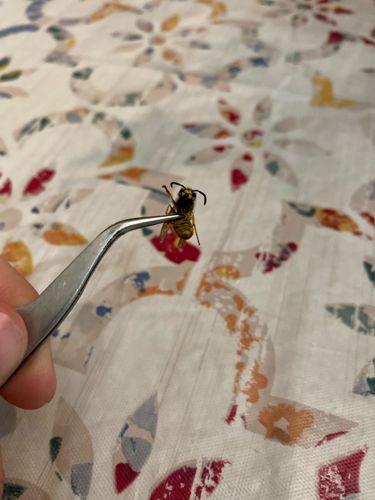Yellowjacket (likely Western Yellowjacket, Eastern Yellowjacket, or German Yellowjacket)
Scientific Name: Vespula spp. or Dolichovespula spp. (difficult to specify exact species without more detailed features)
Order & Family: Order: Hymenoptera, Family: Vespidae (subfamily Vespinae)
Size: Workers typically range from 10-16 mm (0.4-0.6 inches) in length; queens are larger, up to 20 mm (0.8 inches).

Natural Habitat
Nests are typically built in underground burrows, rodent holes, hollow logs, wall voids, attics, or dense shrubs. They are commonly found in suburban and urban areas, forests, and fields where human food sources are available.
Diet & Feeding
Primarily omnivorous. Adults feed on nectar, fruit, and sweet exudates. Larvae are fed chewed-up insects (caterpillars, flies, etc.), spiders, and carrion. They are also attracted to human foods like meats, sugary drinks, and ripe fruit.
Behavior Patterns
Yellowjackets are social insects that live in colonies. They are known for their aggressive defense of their nests, especially late in the summer and early fall when colonies are at their largest. Workers forage for food, often around human activities, and return it to the nest.
Risks & Benefits
Potential Risks: Yellowjackets are known for their painful stings, which can be repeated. They can be very aggressive, particularly when their nest is disturbed, or when foraging for food. Multiple stings can cause a severe reaction, and stings can cause anaphylactic shock in allergic individuals. Potential Benefits: They are beneficial predators of many insect pests, helping to control populations of flies, caterpillars, and other garden pests.
Identified on: 8/15/2025